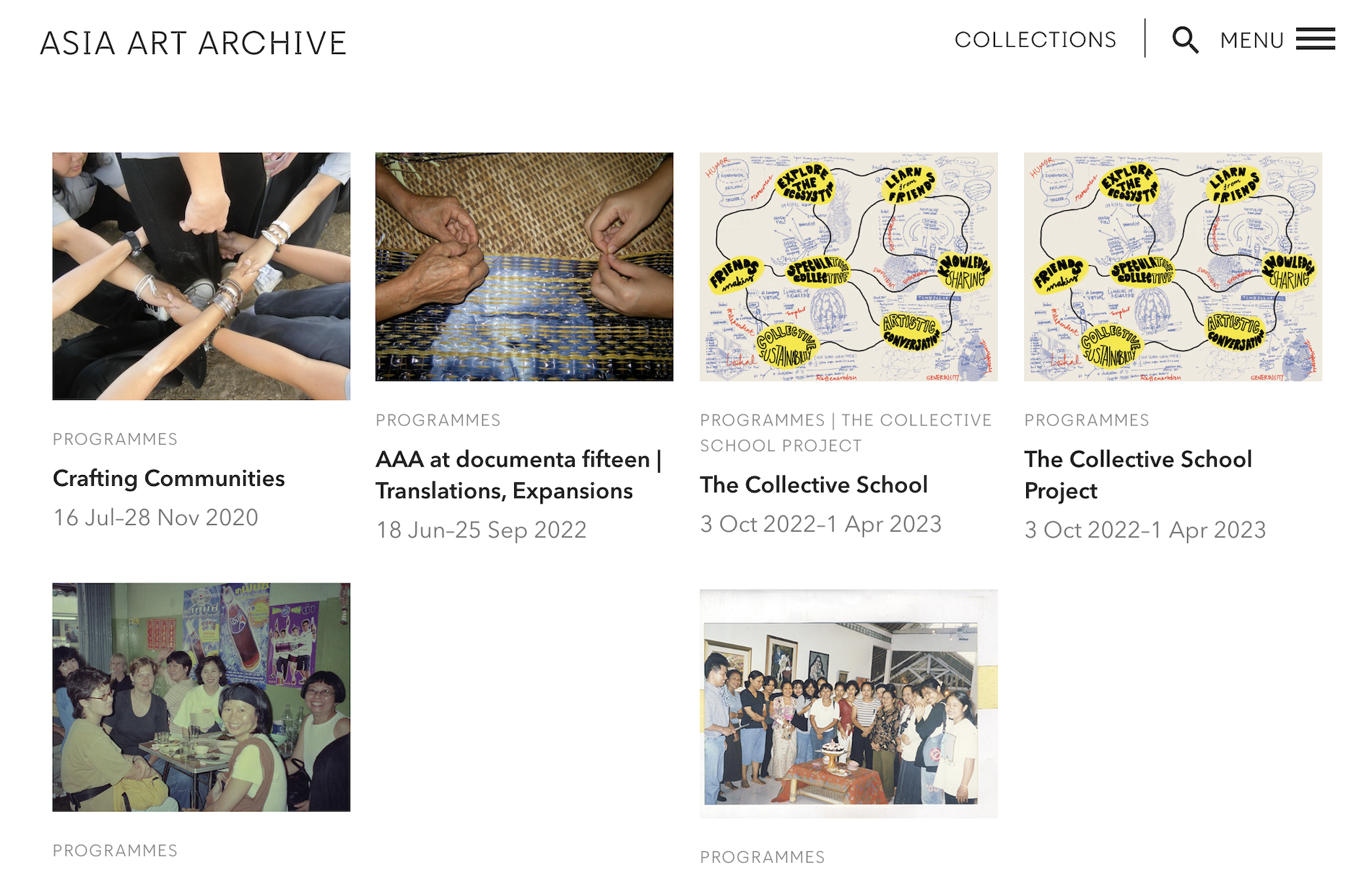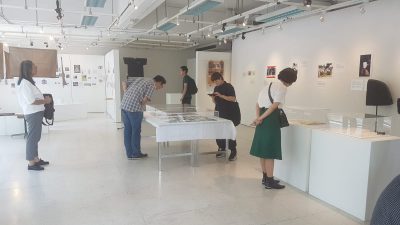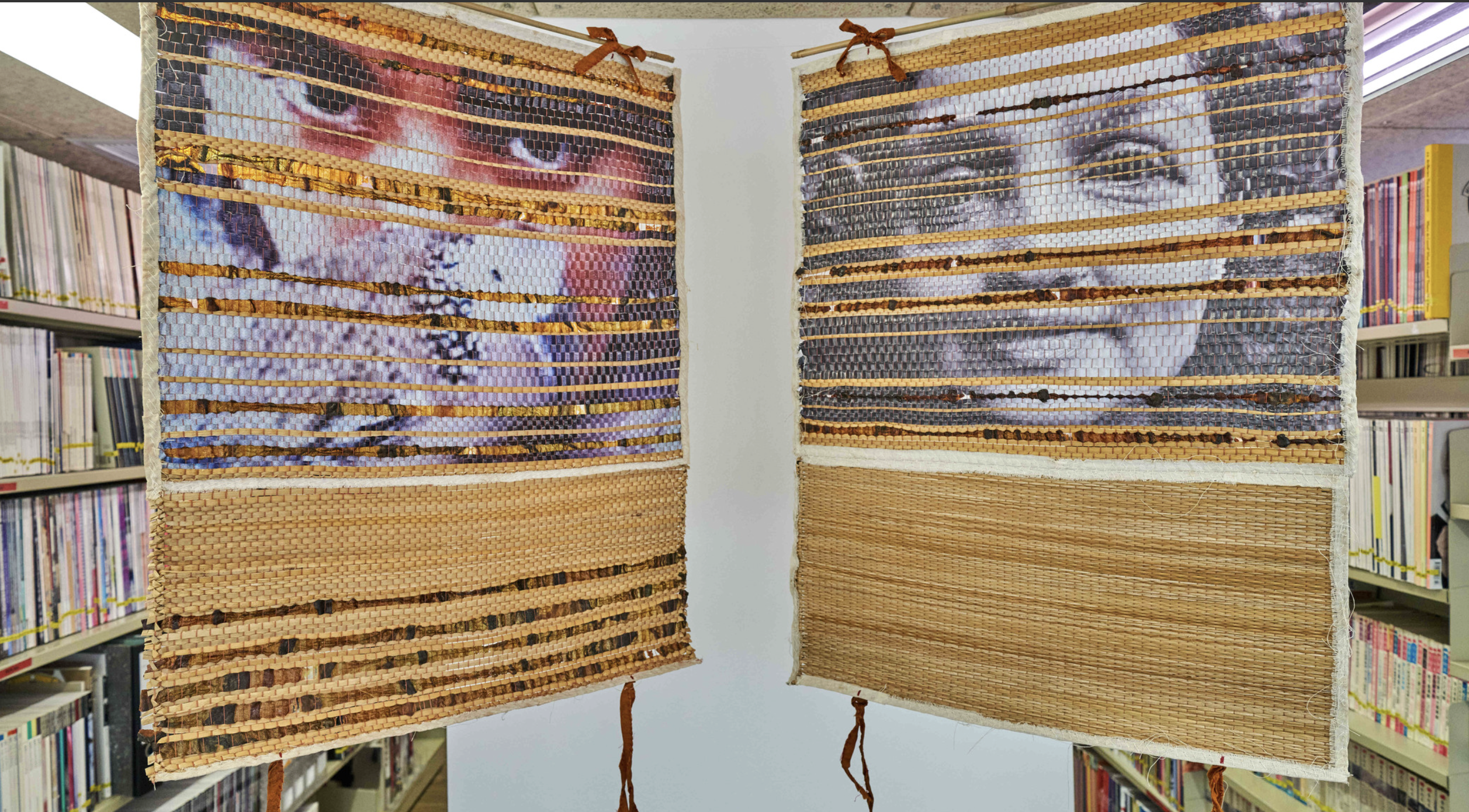By Özge Ersoy
Please note that this publication is currently under review and will be subject to changes.
Stretched across a table, the accordion pages of The Flower of the Nation (2022) unfold, creating a continuous, interwoven narrative of Womanifesto’s history. Scenes of women gathered around a Tradisexion (1995) banner blend into groups seated with children at Boon Bandarn Farm, which in turn flow into hands weaving baskets or typing beside a No Man’s Land (2006) banner. The pages move seamlessly between moments of collaboration and collective action, resisting a strict chronology. Turn the pages over and on the other side, banners in English and Malay proclaim: Women Strike for Peace and Equality, anchoring the work in a persistent call for solidarity.
This woodblock print book was created by Pangrok Sulap (est. 2010), a collective of artists, musicians, and social activists based in Sabah. Created as part of The Collective School exhibition in Hong Kong, the piece grew out of a prompt from Asia Art Archive (AAA) inviting the collective to respond to Womanifesto’s legacy. As they delved into the archival materials, Pangrok Sulap discovered a kinship with Womanifesto’s activities: both practices center the gathering of communities, creating space for dialogue, and linking art to social change.
Just as Womanifesto’s projects weave together exhibitions, workshops, and residencies, Pangrok Sulap teaches rural communities in Malaysia how to draw, carve, and print—sharing tools for both artistic expression and collective survival. Their chosen medium, woodblock printing, is telling of their approach to art making: low-cost, accessible, and resilient for areas with unstable infrastructure, thereby enabling the dissemination of social messages. As they write in Decolonising Design Education: Schools of Departure No. 1, “Instead of being limited to traditional art institutions or galleries, we create a method of collaboration in the form of activities that allow participation from diverse communities, making full use of public and open spaces for community events.”1
The Flower of the Nation therefore functions on multiple levels: it celebrates Womanifesto’s values while reflecting on their resonances with Pangrok Sulap’s own methodology of community-building through collective creativity. Both practices illustrate how artistic production can extend beyond gallery walls into social life, while shaping new forms of pedagogy and communal engagement.
At its core, Asia Art Archive—an independent nonprofit founded in 2000—is committed to expanding and redefining recent art histories in Asia, particularly practices and sites overlooked by dominant narratives. For us at AAA, Womanifesto, an artist collective rooted in pedagogy, collaboration, and social engagement, exemplifies what scholar Eileen Legaspi-Ramirez calls “maintenance work”2—the often-invisible labor that sustains artistic ecosystems. Such work rarely registers in conventional art histories, which privilege individual creators and singular objects. By foregrounding archives such as Womanifesto’s, AAA seeks to challenge this narrow lens.
We ask not only what is made, but how it is made, how it circulates, and whom it sustains. In its ethos, AAA mirrors Womanifesto’s commitment: an insistence on community and knowledge transmission. To further this principle, we do more than collect; we work with the networks that generate these resources, and animate them through research, programs, and publishing. For us, archiving is not preservation alone; it is intervention. What is at stake is whether art histories remain static records of objects and individuals, or whether they continue as living, contested, and collective processes.
Crafting Communities
Echoing Womanifesto, AAA’s work is grounded in collective methodologies. Our post-custodial model allows artists to retain ownership of their physical archives while we organize, digitize, and make them freely accessible on our website. It’s crucial to AAA that archival materials do not remain dormant; they circulate through exhibitions, workshops, residencies, and publications, becoming catalysts for new encounters. Launched on AAA’s website in 2020,3 the digital version of the Womanifesto Archive, assembled over the years by artists Nitaya Ueareeworkaul and Varsha Nair, and supplemented by documents by Phaptawan Suwannakudt in 2020, exemplifies this approach by foregrounding participatory engagement as part of the archival process.
Following the digital launch of the archive, AAA organized Crafting Communities (2020) in its Hong Kong library, curated by then Head of Research John Tain. This exhibition marked the archive’s first physical presentation in our space and highlighted pedagogy as a central thread of Womanifesto’s practice—a focus that reflects a key research interest for our team: exploring the role of artists in shaping models of learning as both cognitive and emotional processes. The project showcased the sensibilities and methodologies of an artistic practice that intersects with traditional crafts while remaining attentive to the needs and rhythms of local communities.
When visitors walked into the library, they first encountered Womanifesto’s beginnings: the catalogue of the 1995 Tradisexion exhibition, a 1997 poster imprinted with a grid of handprints, and a 1996 Bangkok Post Sunday Magazine cover declaring, “Portrait of the Artist as a Thai Woman.” Newspaper clippings from the late 1990s situated these gatherings within global feminist debates. On March 8, 1997, journalist Phatarawadee Phataranawik wrote in The Nation: “Although progress in some Western countries on women’s issues has been achieved since the first [sic] World Conference on Women was held in Nairobi in 1985, women still remain undervalued and discriminated against in Asia.”4 Together, these materials framed Womanifesto’s interventions as both locally grounded and globally conversant, claiming space in male-dominated cultural contexts while participating in broader feminist conversations.
A nearby vitrine displayed a selection from nearly ninety contributions to the portable, multi-editioned project Procreation/Postcreation (2003) alongside materials from the online project No Man’s Land (2006). Both underscored the collective’s commitment to creating platforms for exchange across borders and formats. During a public program at AAA, artist Varsha Nair explained the shared impulse behind these projects: “We cannot wait for others to organize or [to] be invited, [to] be curated. We have to do it for ourselves. The decision to start thinking about the next event began at the first event.”5
The 2001 Womanifesto Workshop and the 2008 Womanifesto Residency in Boon Bandarn further manifested their generative pedagogy. At the other end of AAA’s library, a poster cabinet stood beside Yin Xiuzhen’s Enjoy (2001), an enlarged photograph of the participating artists swimming in a river during the 2001 workshop. While intimate and leisure-filled, as Yin’s notes and other archival materials showed, the workshop was equally about knowledge-sharing. Thirteen artists worked alongside local craftspeople, exploring how artistic practice could carry traditional skills into the present while also responding to rural communities. For instance, Nitaya Ueareeworakul’s sketch for a collaborative sculpture with basket weaver Promma Vanatawee suggested weaving as both material practice and feminist pedagogy. The detailed pencil sketch depicts a basket with a narrow neck that flares into a wider rounded base, giving it an hourglass shape. This artistic proposition suggested that works would keep growing with other people’s contributions building on top of each other.
Discussing how knowledge was passed down in rural areas where the main focus of younger generations was moving to bigger cities, Varsha Nair emphasizes the forms of interactions they were interested in: “It was not that the artist community was meeting up with another community. It was that we were all together forming a community.”6 This distinction underscores the very nature of Womanifesto’s practice: a feminist methodology inseparable from its context, attentive to the infrastructures of knowledge and mutual support that enable art to circulate beyond galleries and into everyday life.
Archival records from the 2008 Womanifesto Residency deepened this picture. Over the course of a month, artists co-created installations with children, students, and villagers, reimagining the intersection of contemporary art and vernacular crafts. On-Anong Glinsiri’s Togetherness & the Way We Were (2008) offered a visually striking outcome. Selected from a larger series, two intimate portraits of Varsha Nair and the artist, both gazing directly into the camera, were woven into grass mats interlaced with printed vinyl strips. The result was both portraits and textiles to sit on—part of a collective self-representation of the women who sustained the project. We suspended these pieces above a study desk in our library, in a similar gesture to blur the boundaries between an artwork, a daily object, and an archival document.
Translations, Expansions
One year after Crafting Communities, the AAA team received an invitation from ruangrupa, the Jakarta-based collective, to participate in documenta fifteen. This opportunity allowed us to place the Womanifesto Archive in dialogue with other artist collectives whose practices similarly foreground pedagogy, collective engagement, and archival intervention. Documenta fifteen was structured around the principle of lumbung—the communal rice barn—as a conceptual and methodological framework: a model emphasizing resource-sharing, reciprocity, and collectivity. Aligning with this ethos, Womanifesto’s self-organized, intergenerational approach became one of the central pillars of AAA’s presentation.
Titled Translations, Expansions, AAA’s contribution focused on three artistic and collective practices featured in AAA Collections: Womanifesto; the Living Traditions movement at MS University of Baroda in post-independence India; and the regional networks of performance art festivals in East and Southeast Asia at the turn of the century.7 The presentation emphasized how artists reinterpret knowledge embedded in daily life—craft traditions, vernacular practices, and embodied skills—and transmit it to future generations. Here, preservation is not static; it is a relational activation of knowledge, a process that keeps artistic histories alive through participation, teaching, and communal engagement—a sensibility that directly informs AAA’s approach to archiving.
The Baroda component highlighted the work of artists associated with the Faculty of Fine Arts, including K. G. Subramanyan, Jyoti Bhatt, and Nilima Sheikh. This community dedicated itself to documenting, studying, and teaching traditional and vernacular art practices in post-independence India, raising questions about the relationship between the divide of modern and traditional art in a postcolonial context. On display were artworks and archival materials that captured this pedagogical impulse: rangolis (threshold paintings) and stencils, as well as outdoor installations and handmade toys from the Fine Arts Fairs, which, from the 1960s to the 1980s, provided a community-driven platform for students and teachers to experiment with traditional art forms. In this way, the Baroda community, like Womanifesto, viewed artistic practice as inseparable from teaching and knowledge transmission, demonstrating the generative potential of collective study.
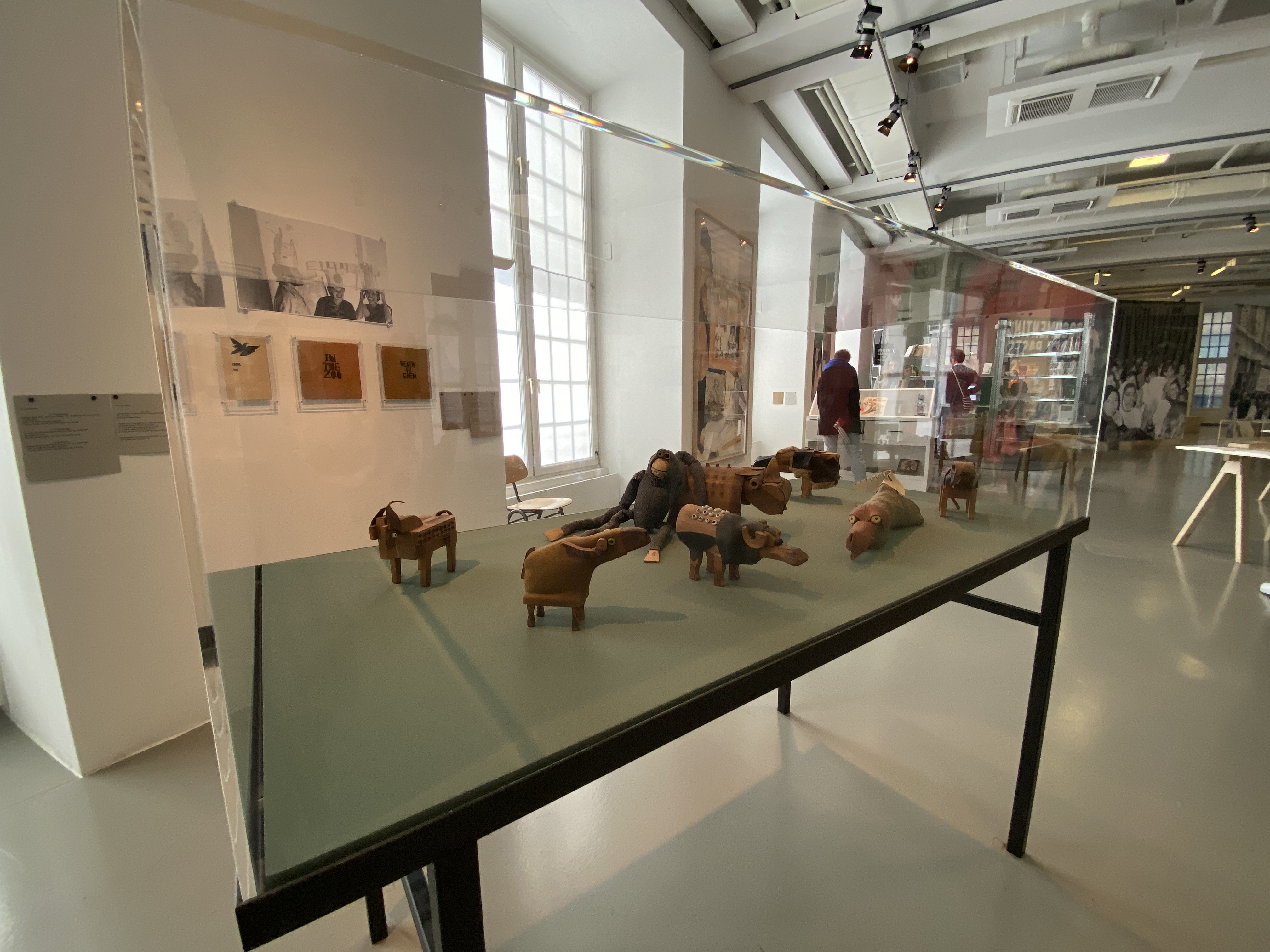
The section on performance art festivals traced artists’ networks across East and Southeast Asia in the 1990s and 2000s, including Artists' General Assembly (Singapore), Jakarta International Performance Art Festival, Nippon International Performance Art Festival, Hong Kong On the Move Performance Art Project, Beyond Pressure International Performance Art Festival (Yangon), and OPEN International Performance Art Festival (Beijing). The featured performance videos showcased the use of everyday materials and vernacular settings as sites of creative exploration. Artists, such as Lee Wen and Ray Langenbach, acted as both participants and self-archivists, documenting their own histories while creating platforms for peer-to-peer knowledge exchange. In this context, the festivals functioned as living archives, where performance, pedagogy, and community were inseparable.
Echoing the values of these two distinct groups of artists, the Womanifesto section presented archival materials alongside artworks that traced the collective’s sustained engagements with place, memory, and community. Suspended from the ceiling, Karla Sachse and Khun Pikul Deelong-Ngam’s Female Vessel (2001)—a basket form woven from plant fiber and paper—interlaced discarded newspapers with handwritten notes by workshop participants and people on the farm, transforming everyday ephemera into a vessel of shared voices and lived experience.
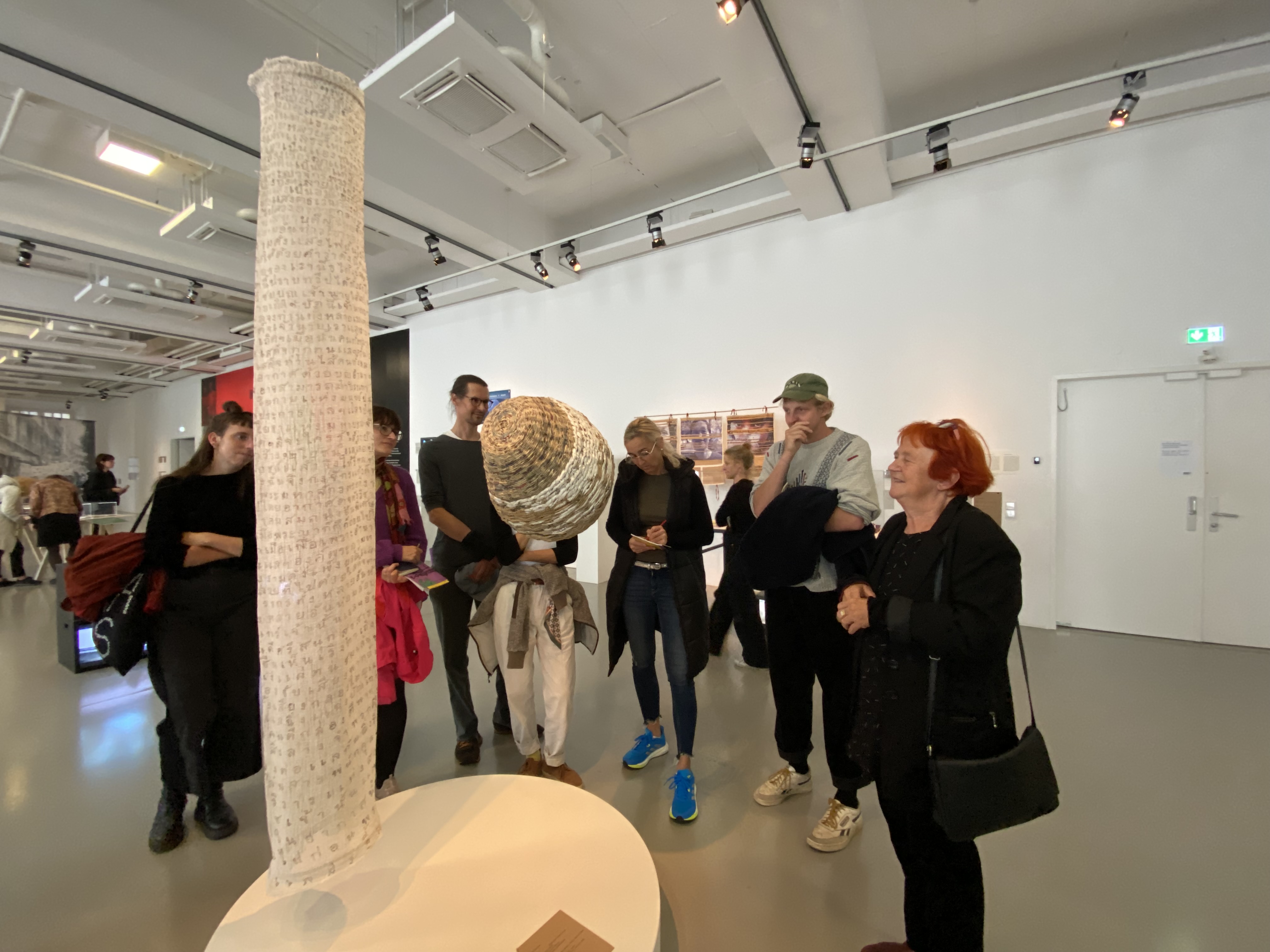
Nearby, Phaptawan Suwannakudt’s Cast… off Memory (2008), a handloom-woven fabric sculpture over two meters tall, layered fading ink inscriptions with recollections of the farm, her ancestral home, and her father, embodying the fragility and persistence of intergenerational memory. In contrast, Varsha Nair’s video Lullaby for a Storm (2008) juxtaposed the intimacy of a lullaby sung to a child with the television broadcast of political unrest, entwining care and vulnerability with the turbulence of public life. Together, these works illuminated Womanifesto’s relational mode of practice—transforming personal and collective experiences into forms of shared knowledge—while making visible the porous boundaries between the domestic, the political, and the artistic.

Juxtaposing Womanifesto with Baroda’s Living Traditions and regional performance networks showcased how artists collectively operate as custodians, mediators, and transmitters of knowledge. Furthermore, our display unfolded alongside initiatives such as The Black Archives in Amsterdam and Archives des luttes des femmes en Algérie, underscoring the social and political stakes of archival practice.8 These two comparative framings resonated with our own understanding of archives as not inert containers but generative infrastructures and engines of pedagogical innovation.
The Collective School
Building on the insights from Translations, Expansions, the AAA team began reimagining our library space in Hong Kong, initiating a renovation that ultimately transformed the library into a space for collective and experiential learning. This shift crystallized in The Collective School (2022–23), the first exhibition following the renovation, which asked: How do collectives teach and learn?9
Developed in collaboration with Gudskul, a Jakarta-based collective, The Collective School brought together eight artist collectives from across Asia to engage with archival materials from our collections, documenting three collective practices that emerged in the 1980s and 1990s: Womanifesto; Xiamen Dada, a collective known for their radical performative actions critiquing the art system in China in the 1980s; and Black Artists in Asia, a collective that initiated VIVA ExCon, the longest-running artist-run biennial in the Philippines, in the 1990s. The participants’ contributions—ranging from videos, sculptures, and zines to games and interactive installations—emerged through regular group conversations, where the process of exchange was as significant as the final presentation.10
Over the course of a year, participants engaged in a series of workshops with AAA researchers, educators, and curators. Rather than staging a traditional display, the project activated the library as a living infrastructure for collaboration. By convening groups committed to resource-sharing and rootedness in local contexts, AAA extended lessons of Womanifesto’s intergenerational, community-oriented approach into its own institutional methodology.
Within this framework, individual works resonated with one another in unexpected ways. Pangrok Sulap’s woodblock print book The Flower of the Nation, suspended in a wooden display case, was situated within Salikhain Kolektib’s (est. 2017) mirrored installation Manifesting (In)constancy (2022). The Quezon City–based collective designed a structure that housed archival materials from Womanifesto and their own collective, alongside Pangrok Sulap’s woodcut print, setting up a tension between the linearity of chronological timelines and the fractured, multi-angle reflections produced by the mirror surfaces. The installation suggested how the collaborative processes, iterative gestures, and relational dynamics are inherent in the creation of their respective works.
Bishkek School of Contemporary Art’s (BiSCA) (est. 2020) interventions complemented and expanded the propositions of Pangrok Sulap and Salikhain Kolektib. Round Table (2022), a card game for three to six players, invited participants to respond to prompts through drawing or writing, gradually assembling a zine that documented their exchange. The Portal (2022), a 96-minute video centered on the Altyn Kazyk Library of Saved Books in Bishkek, gestured toward the library as a community-built space for discovery and artistic production. Together with their Aralash zine series, these works underscored peer-to-peer learning and multiplicity, echoing the recursive effect of mirrored reflections.
Extending this spirit of experimentation, the Hong Kong–based collective Floating Projects (est. 2015), one of our local partners, approached the question of collective learning through play and improvisation. As a public program they staged Assemblage at AAA (2023), a two-day durational performance that transformed the library into a site of spontaneous making. Members brought in found objects, materials from AAA’s library and office, and items from their own studio, and began creating in situ. One artist devised a chess-like game, others constructed a sculpture using shredded confidential documents, while still others engaged in automatic writing. Visitors were invited to join at any point, blurring the line between performer and participant. By foregrounding contingency, chance, and shared action, Floating Projects animated the archive as a space of play, where knowledge emerged not from preservation alone but through collective improvisation and embodied encounters.
Each participant’s contribution refracted and amplified others’ gestures, generating layered understandings of collective practice. The library, zines, mirrored installations, card games, and improvised performances together demonstrated that archives thrive when activated as dialogical spaces—sites where knowledge is transmitted, contested, and shared across generations and geographies.
Archives as Methods
A central question guides AAA’s work with archives: how can creative annotations, personal reflections, and collective memory be kept alive? This question crystallized during my conversation at the Sharjah Biennial 2025 with artists Varsha Nair, Jamilah Preenun Nana, and Nitaya Ueareeworakul, in front of Lena Eriksson’s From Here and From There (2025). Exhibited as part of Womanifesto’s contribution to the biennial, Eriksson’s drawings, videos, and stories reflecting on the 2008 residency exemplified the delicate work of sustaining knowledge. Accompanying her drawing of Phaptawan Suwannakut’s works and life, Eriksson’s note—“Only, how am I supposed to tell this to the blind horse. Maybe I’ll just stroke his nose”—encapsulates the ineffable labor of holding and transmitting memory.
This artwork brings me back to scholar Yvonne Low who underscores the interpretative dimensions of archive-making in Womanifesto’s practice. In a panel organized by AAA, AWARE: Archives of Women Artists, Research and Exhibitions, and Indonesian Visual Art Archive in Yogyakarta, Low noted that this sensibility has been present since the collective began documenting and archiving its own activities, citing the handmade photo albums from Womanifesto workshops with fabric covers sewn by artist Nitaya Ueareeworakul. For Low, these covers transformed the albums into more than containers of images: “These fabric covers function as more than mere protection for the album. In as much as it serves to aestheticize the album and subjectivize the viewing process, these covers enable [Nitaya Ueareeworakul] to partake in the story-telling process.”11
In the context of Womanifesto’s practice, the act of archiving becomes inseparable from artistic practice itself—an extension of custodianship, creativity, and collective authorship. As Womanifesto continues to document and archive its work, it demonstrates how records are always open to interpretation, inviting participants and audiences alike to engage in ongoing processes of meaning-making.
AAA’s engagement with Womanifesto embodies this principle. A throughline emerges across the three initiatives discussed above—Crafting Communities, The Collective School, and Translations, Expansions. Archives are living and generative, and preservation alone is never sufficient: knowledge circulates only when communities engage with it, adapt it, and pass it on. Feminist methodologies guide this work, questioning hierarchies of knowledge, multiplying perspectives, and insisting that learning be collective and experiential.
1 Pangrok Sulap, ‘Empowering Community Through Art,’ in JJ Adibrata, Regina Bittner, Katja Klaus, and Philipp Sack (eds.) Decolonizing Design Education: Schools of Departure No. 1, Stiftung Bauhaus Dessau, Dessau, 2023, p.(pages to be supplied)
2 Eileen Legaspi-Ramirez, ‘Art on the Back Burner: Gender as the Elephant in the Room of Southeast Asian Art Histories’, Southeast of Now: Directions in Contemporary and Modern Art in Asia, vol. 3, no. 1, pp. 25–48.
3 The Womanifesto Archive was digitised and prepared for access by John Tain, Ali Wong, and Garfield Chow in AAA’s Research team, and reviewed and approved by Elaine Lin and Gabrielle Chan in Collections. Intern Lora Fong provided assistance. The online archive project was made possible through the generous support of the AAA Women and Gender Diversity Fund: Jonathan Cheung, Geoffrey Chuang, Luke Fehon, Shirazeh Houshiary / Lisson Gallery, Margie Lau, Dee Poon, Ed Tang, and Claudine Ying. See ‘Womanifesto Archive’, Asia Art Archive, https://aaa.org.hk/en/collections/search/archive/womanifesto-archive, accessed 7 October 2025.
4 Phatarawadee Phataranawik, ‘Sisters in Arms’, The Nation, March 8, 1997, pp. C1–C2. The World Conference on Women in Nairobi was the Third World Conference on Women, following the First World Conference on Women in Mexico in 1975 and the Second World Conference on Women in Copenhagen in 1980.
5 Varsha Nair, Phaptawan Suwannakudt and Eileen Legaspi-Ramirez, ‘Backyards and Neighbourhoods: Feminist Strategies and Communities’, talk organized by Asia Art Archive, November 17, 2020. For documentation and more information see ‘. https://aaa.org.hk/en/programmes/programmes/backyards-and-neighbourhoods-feminist-strategies-and-communities, accessed 7 October 2025.
6 Ibid.
7 The working team for Translations, Expansions included Pallavi Arora, Samira Bose, Gabrielle Chan, Sam Chao, Susanna Chung, Özge Ersoy, Christopher K. Ho, Lydia Lam, Charlotte Mui, Sneha Ragavan, John Tain, Rebecca Tso, and Debby Tsui. Thanks to Carol Choi, Paul C. Fermin, Leah Lam, Paco Ma and Chương-Đài Võ. The project was generously supported by documenta gGmbH, as well as Wendy Lee & Stephen Li, and Virginia & Wellington Yee.
8 AAA was part of one of the mini-majelis—groups that regularly met to exchange ideas and share resources—at ‘documenta fifteen’, which included Another Roadmap Africa Cluster (Kampala, Nyanza, Lubumbashi, Kinshasa, Maseru, Johannesburg, Lagos, and Cairo), Archives des luttes des femmes en Algérie (Algiers), Centre d'art Waza (Lubumbashi), El Warcha (Tunis), Graziela Kunsch (São Paulo), Keleketla! Library (Johannesburg), Komîna Fîlm a Rojava (Rojava), Sada [regroup] (Baghdad and other locations), Siwa Platforme - L'Economat at Redeyef (Redeyef), and The Black Archives (Amsterdam), who presented their projects at the Fridericianum in Kassel.
9 The Collective School was developed by Susanna Chung, Özge Ersoy, and Rebecca Tso, in close collaboration with Samira Bose, Noopur Desai, Sneha Ragavan, John Tain, Chương-Đài Võ, Congyang Xie, and Anthony Yung. The project was generously supported by the Hong Kong Arts Development Council, as well as Wendy Lee & Stephen Li, and Virginia & Wellington Yee.
10 Participants in The Collective School included ba-bau AIR (Hanoi), BiSCA (Bishkek), Gudskul (Jakarta), Load na Dito (Quezon City), Omnispace (Bandung), Pangrok Sulap (Sabah), Salikhain Kolektib (Quezon City), Scutoid Coop (Kaohsiung), and Yayasan Tonjo Foundation (Yogyakarta), as well as two local partners: Floating Projects (Hong Kong) and Rooftop Institute (Hong Kong).
11 Yvonne Low, ’Artists-Organisers: Conditioning Art and its Narratives’ panel presented at The Flow of History: Southeast Asian Women Artists (Yogyakarta), co-organized by Asia Art Archive, AWARE: Archives of Women Artists, Research and Exhibitions, and Indonesian Visual Art Archive, Yogyakarta, Indonesia, November 16, 2024. Documentation and more information avaliable at https://aaa.org.hk/en/programmes/programmes/the-flow-of-history-southeast-asian-women-artists-yogyakarta.
Özge Ersoy is Executive Director at Asia Art Archive in Hong Kong, where she previously served as Senior Curator and Public Programmes Lead. Her recent projects include co-curating In Our Own Backyard (2025) and Countering Time (2024) at AAA’s library. Before joining AAA, she was Curator and Program Manager of collectorspace, Istanbul. She is also Managing Editor of m-est.org, an online publication conceived as an artist-centered initiative.
Related pages
Share a Reflection
log in to share a reflection.
